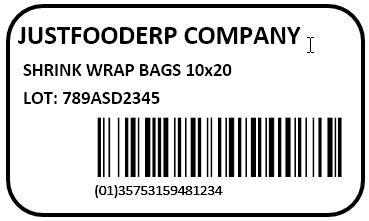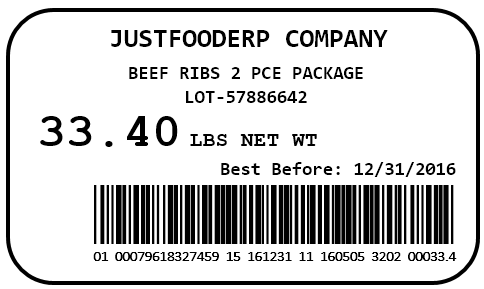If your vendors use GS1-128 bar codes, you will need to set up a GS1-128 bar code type, which will allow you to scan their bar codes during warehouse processes.
GS1-128 bar codes are also used on the Inventory Label report. For a bar code to be used on the Inventory label, it needs to have the Default check box selected. Note: A default GS1-128 bar code is delivered.
Important: You need to set up your hand-help scanner so that it inserts a separator when scanning. And the separator that was set on the scanner needs to be entered in the GS1 Separator Character (Unicode) field on the Bar Code Setup window.
You need to find out the following from your vendors:
- Global Trade Item Number (GTIN) for the items they sell.
- Data fields that they use in their bar codes.
Prerequisites:
Example:
Your vendors create GS1-128 bar codes that resemble the following:
To be able to scan these labels, a bar code type is set up as follows:
To define GS1-128 bar codes
-
Open the Bar Code Types window.
Navigate to /Departments/Administration/Application Setup/Warehouse/Labels/Bar Code Types.
-
Click New. The Bar Code Type Code Card window opens.
-
Enter the following information in the General FastTab:
Field Description Code Code that represents the bar code. Description Enter a description of the bar code. Type Select GS1-128. Default Select this check box if you want the GS1 bar code to be used on the Inventory Label report. Allow Parsing Select this check box, which allows this bar code type to be considered when trying to match a scanned bar code with a bar code type code. Parse Order Enter the order in which a bar code is considered when trying to match a scanned bar code with a bar code type code. The lower the number, the higher the priority. -
Enter the following information in the Parsing FastTab. The Parsing FastTab contains the information that allows JustFoodERP to determine whether an incoming scanned barcode matches a bar code type.
Field Description Fixed Length Leave blank. First Two Chars are Numeric Select this check box. First Two Chars are Valid AI Select this check box. First Data Segment is Valid AI Select this check box. List of Possible First Chars Leave blank. -
Enter the following information in the Details FastTab:
Field Description Map To Field Select the field that the scanned data will be mapped to. Priority If you enter the same Map to Field values, enter a number to indicate which data field is given priority. The lower the number, the higher the priority. Data Field Type Select the data field type.
GS1 AI: GS1 application identifier. The data field indicates the type of data that follows identifier. When this value is selected, a value must be entered in the Data Field Code field. This value only applies when the type is GS1-128. When using GS1 AI, the data in the bar code must follow the standards as defined in the GS1 identification guidelines.
-
Constant: Indicates that a defined value should be used. The Constant value is used when matching data cannot be found. When this value is selected, you need to enter a value in the Data Field Value field.
Data Field Code If you selected GS1 AI for the Data Field Type field, then select the application identifier that corresponds to the data that you're mapping to. Must Existing when Parsing When this check box is selected, the data field must exist when the bar code is scanned.
Data Field Position Leave blank. Data Field Length Leave blank. Data Field Value Indicates the value that should be automatically assigned to the data. This field is used when Constant is selected for the Data Field Type field. Description Enter a description of the line. -
Click OK.
Cross reference the GTINs to an item. This allows you to associate a global trade item number (GTIN) to your item.
Open the item card for an item that you purchase from a vendor.
-
On the Navigate tab, in the Master Data group, choose Cross References.
-
Select Bar Code for the Cross-Reference Type No. field.
-
In the Cross-Reference No. field, enter a valid global trade item number (GTIN). For GS1 bar codes, the GTIN needs to be 14 numbers.
Note: You must enter a valid GTIN otherwise the bar code cannot be scanned correctly.
To generate a valid GTIN-14 for test data, go to https://www.gs1us.org/resources/tools/check-digit-calculator.
-
Select the unit of measure that applies to the entered GTIN in the Unit of Measure field. All GTINs have their own specific UOM.
-
Select a GS1 bar code type in the Bar Code Type Code field.
-
Click OK.
 Tip Tip |
|---|
For more information about how to work with fields and columns, see Work with Data. For more information about how to find specific pages, see Search. |








